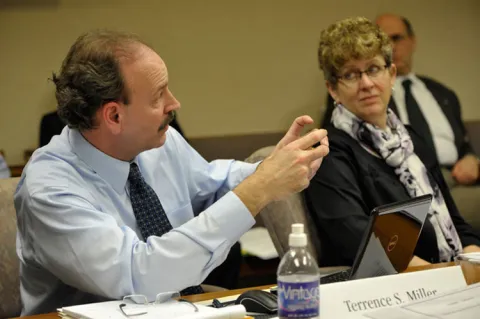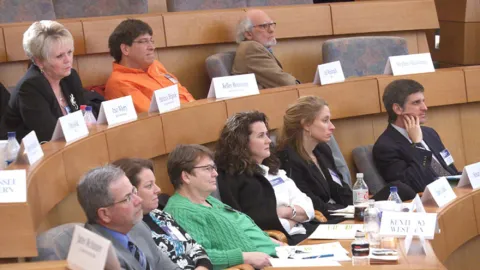Serving the public in a secure environment is a key goal of the Strategic Plan for the Federal Judiciary. Many measures have been taken in recent years to protect the safety of visitors, judges, and court employees, while containing the costs of courthouse space and services as federal dollars shrink.

The Judiciary takes numerous steps to ensure a secure environment for judges, court staff, and the public they serve.
Circuit-Based Space and Security Training
The National Space and Security Circuit Training Program was developed to provide court unit executives and their staffs with detailed information on programs relating to courthouses. A two-day curriculum developed by court managers and staff from the AO and FJC addresses such topics as occupancy-related agreements, the long-range facilities planning process, the circuit rent budget process, space assignment and rent validation, courtroom technologies, personal property management, and judicial facility security. By the close of 2011, workshops had been held in every circuit.
Tenant Alterations Pilot Program
A provision in the 2009 Omnibus Appropriations Act (Pub. L. No. 111-8) empowered the Administrator of the GSA to delegate authority to the Judiciary to enter directly into real property alteration contracts with private-sector companies for projects up to $100,000 in value. The new delegation of authority enables courts to make minor alterations more efficiently, so that GSA can focus on the larger, more complex Judiciary space projects.
Three projects, at similar stages of development, were approved for participation in a pilot program, and each received the required delegation from GSA during 2011. The AO worked with all three courts to prepare and plan to procure services from architects and general contractors. A Chicago court project was withdrawn from the pilot after the need for costly asbestos abatement was identified. The two remaining project courts, Des Moines, Iowa, and Washington DC, successfully procured general contractors with construction completion anticipated by late 2011 and early 2012, respectively. The Judiciary expects an evaluation of the program to be completed by early 2012.
Facilities Cost Savings
The Committee on Space and Facilities discussed initiatives within its jurisdiction and recommended initiatives for further discussion at the September 2011 Cost Containment Budget Summit. Some of the short-term initiatives that the Committee discussed were reducing overtime utilities and parking costs; deferring the tenant alterations and cyclical maintenance allotments; and reviewing GSA project management fees. Longer-term initiatives that the Committee is addressing include studying the closure of non-resident courthouses and reducing the leased space occupied by probation and pretrial services offices.

Informing judges about personal safety issues is a top priority for the Administrative Office
Security Awareness
Project 365: Security Starts with You is the educational component of the Judicial Conference Committee on Judicial Security's awareness program. It encourages judges to be aware of, and practice, personal security. In May 2011, the AO released the first installment in a series of nine monthly security awareness videos for judges. The videos, which run about three minutes, provide information on false liens, protective details for judges, courtroom security, inappropriate communications, travel safety, Internet security, security when commuting, suspicious packages, and residential security. The videos were produced by the AO in consultation with the U.S. Marshals Service.
Continuity of Operations (COOP) and Emergency Preparedness
The AO assists courts with emergency preparedness training and exercises, as well as developing and testing responses to catastrophic events that could potentially affect Judiciary employees, court operations, court facilities, and equipment.
COOP Tabletop Exercises
In February 2011, court officials from the Southern District of Georgia discussed emergency preparedness planning issues during an informal tabletop exercise at the U.S. Courthouse in Savannah. In close coordination with the AO Judiciary Emergency Preparedness Office (JEPO), the U.S. Marshals Service Office of Emergency Management facilitated the tabletop exercise, which included local representatives from the GSA, Federal Protective Service, and Georgia's Chatham County Emergency Management Agency. In addition to testing emergency responses, the exercise also updated participants on developments in the district's court security and emergency preparedness programs. In July and September 2011, the USMS coordinated similar district-wide COOP tabletop exercises in the Eastern District of North Carolina at Raleigh, and in the Eastern District of Texas at Tyler. Clerks of court, IT and probation office staff, and U.S. Attorney's Office and Federal Protective Service personnel participated in the exercise.
In June 2011, the AO and selected court personnel with experience in responding to disasters affecting courthouses, and FJC staff, coordinated a two-day emergency preparedness workshop for the Northern District of Illinois in Chicago and the Seventh Circuit Court of Appeals. The workshop provided a forum for the various court units, as well as federal agencies such as the Department of Justice, Department of Homeland Security, Federal Protective Service and GSA. They hear from court unit executives who have experienced emergencies, including the 9/11 terrorist attacks, hurricanes, and floods. The tabletop exercise enabled the interagency team in GSA's Dirksen Federal Building to consider emergency preparedness and response actions, from situational awareness to activation and relocation, and from alternate site operations to reconstitution.
2011 COOP Conference, Ninth Circuit
In March 2011, the Ninth Circuit, in consultation with the AO and the FJC, conducted a COOP conference and workshop for courts in San Diego, California. Representatives with responsibilities for emergency preparedness from the circuit's 15 judicial districts attended the conference. The conference included panels on geological and seismic hazards affecting the Ninth Circuit; recent emergency response events in the Judiciary; information technology, telecommunications and human resources in support of court emergency preparedness planning; and the roles and responsibilities of the USMS and FEMA.
Court unit executives discussed past events that tested COOP and emergency preparedness plans, such as fatal shootings, terrorist attacks, and weather-related court closures, including wildfire smoke and unusually heavy snowfall.

Court and AO representatives participated in the National Level Exercise 2011, a White House-directed emergency preparedness event.
National Level Exercise 2011
The National Level Exercise 2011 (NLE 2011) was a White House-directed, congressionally-mandated exercise that included federal department and agency senior officials, and key operational elements. FEMA envisioned NLE 2011 as a campaign of emergency preparedness events, and planning efforts involving a domestic, non-terrorism incident. The scenario involved a catastrophic earthquake in the New Madrid and Wabash Valley Seismic Zones, a seismically active geographic area in the Midwest that threatens eight states.
NLE 2011 was conducted from May 16-20, 2011, and U.S. courts and federal agencies in each of these eight states conducted COOP exercises. This was the first time the Judiciary participated in a national-level exercise of this scale. Exercise preparation required close coordination between the JEPO, FEMA, DOJ, and participating courts and court units.
After the exercises, the AO scheduled post-exercise briefings via video conference and teleconference, and then posted the courts' findings on the Judiciary intranet site.
Courthouse Flooding, St. Louis, Missouri
On August 23, 2011, a water line ruptured on the 17th floor of the Eagleton Courthouse in space assigned by the GSA to the USMS for a holding cell. Water leaked from the ruptured line for several hours unchecked in the area that was unoccupied at the time, causing extensive damage to several courtrooms and court office space.
The AO met periodically with the court to assist with the flood damage. In October 2011, the House Committee on Appropriations responded to the GSA's reprogramming request for $10 million to repair the Eagleton Courthouse, redirecting funds from construction and renovation projects funded in prior year appropriations acts. The renovation project will be completed over several months.
AO Business Continuity and Emergency Preparedness
The AO regularly updates and tests its business continuity and emergency preparedness plans to ensure continued support to the Judiciary during events that render AO facilities inaccessible. The AO regularly tests its emergency communications systems and conducts evacuation exercises and shelter-in-place drills. Telework exercises are scheduled to help the AO validate that personnel are able to perform business functions remotely.
In FY 2011, the AO activated business continuity plans in response to the major snow storms that impacted the Washington, DC Metropolitan area. Prior tests and exercises allowed the AO to prepare for the events and continue operating even when the majority of staff were unable to report to the physical workplace.
